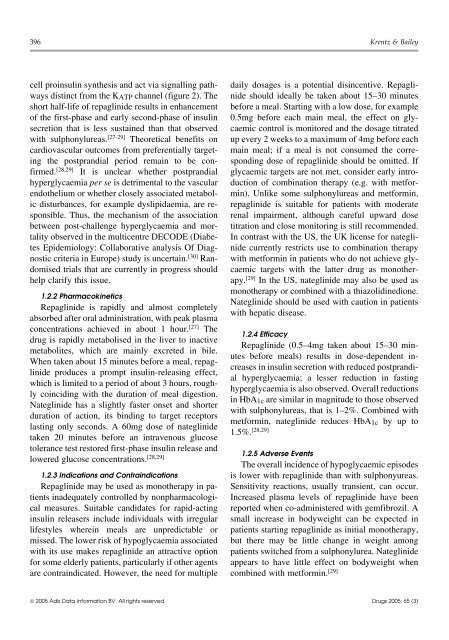Oral Antidiabetic Agents - Luzimar Teixeira
Oral Antidiabetic Agents - Luzimar Teixeira
Oral Antidiabetic Agents - Luzimar Teixeira
Create successful ePaper yourself
Turn your PDF publications into a flip-book with our unique Google optimized e-Paper software.
396 Krentz & Bailey<br />
cell proinsulin synthesis and act via signalling path- daily dosages is a potential disincentive. Repagliways<br />
distinct from the KATP channel (figure 2). The nide should ideally be taken about 15–30 minutes<br />
short half-life of repaglinide results in enhancement before a meal. Starting with a low dose, for example<br />
of the first-phase and early second-phase of insulin 0.5mg before each main meal, the effect on glysecretion<br />
that is less sustained than that observed caemic control is monitored and the dosage titrated<br />
with sulphonylureas. [27-29] Theoretical benefits on up every 2 weeks to a maximum of 4mg before each<br />
cardiovascular outcomes from preferentially target- main meal; if a meal is not consumed the correing<br />
the postprandial period remain to be con- sponding dose of repaglinide should be omitted. If<br />
firmed. [28,29] It is unclear whether postprandial glycaemic targets are not met, consider early introhyperglycaemia<br />
per se is detrimental to the vascular duction of combination therapy (e.g. with metforendothelium<br />
or whether closely associated metabol- min). Unlike some sulphonylureas and metformin,<br />
ic disturbances, for example dyslipidaemia, are re- repaglinide is suitable for patients with moderate<br />
sponsible. Thus, the mechanism of the association renal impairment, although careful upward dose<br />
between post-challenge hyperglycaemia and mor- titration and close monitoring is still recommended.<br />
tality observed in the multicentre DECODE (Diabe- In contrast with the US, the UK license for nateglites<br />
Epidemiology: Collaborative analysis Of Diag- nide currently restricts use to combination therapy<br />
nostic criteria in Europe) study is uncertain. [30] Ran- with metformin in patients who do not achieve glydomised<br />
trials that are currently in progress should caemic targets with the latter drug as monotherhelp<br />
clarify this issue.<br />
apy. [29] In the US, nateglinide may also be used as<br />
monotherapy or combined with a thiazolidinedione.<br />
1.2.2 Pharmacokinetics<br />
Nateglinide should be used with caution in patients<br />
Repaglinide is rapidly and almost completely<br />
with hepatic disease.<br />
absorbed after oral administration, with peak plasma<br />
concentrations achieved in about 1 hour. [27] The<br />
1.2.4 Efficacy<br />
drug is rapidly metabolised in the liver to inactive<br />
Repaglinide (0.5–4mg taken about 15–30 minmetabolites,<br />
which are mainly excreted in bile.<br />
utes before meals) results in dose-dependent in-<br />
When taken about 15 minutes before a meal, repagcreases<br />
in insulin secretion with reduced postprandilinide<br />
produces a prompt insulin-releasing effect,<br />
al hyperglycaemia; a lesser reduction in fasting<br />
which is limited to a period of about 3 hours, roughhyperglycaemia<br />
is also observed. Overall reductions<br />
ly coinciding with the duration of meal digestion.<br />
in HbA1c are similar in magnitude to those observed<br />
Nateglinide has a slightly faster onset and shorter<br />
with sulphonylureas, that is 1–2%. Combined with<br />
duration of action, its binding to target receptors<br />
metformin, nateglinide reduces HbA 1c by up to<br />
lasting only seconds. A 60mg dose of nateglinide<br />
1.5%.<br />
taken 20 minutes before an intravenous glucose<br />
[28,29]<br />
tolerance test restored first-phase insulin release and<br />
1.2.5 Adverse Events<br />
lowered glucose concentrations. [28,29]<br />
The overall incidence of hypoglycaemic episodes<br />
1.2.3 Indications and Contraindications is lower with repaglinide than with sulphonyureas.<br />
Repaglinide may be used as monotherapy in pa- Sensitivity reactions, usually transient, can occur.<br />
tients inadequately controlled by nonpharmacologi- Increased plasma levels of repaglinide have been<br />
cal measures. Suitable candidates for rapid-acting reported when co-administered with gemfibrozil. A<br />
insulin releasers include individuals with irregular small increase in bodyweight can be expected in<br />
lifestyles wherein meals are unpredictable or patients starting repaglinide as initial monotherapy,<br />
missed. The lower risk of hypoglycaemia associated but there may be little change in weight among<br />
with its use makes repaglinide an attractive option patients switched from a sulphonylurea. Nateglinide<br />
for some elderly patients, particularly if other agents appears to have little effect on bodyweight when<br />
are contraindicated. However, the need for multiple combined with metformin. [29]<br />
© 2005 Adis Data Information BV. All rights reserved. Drugs 2005; 65 (3)

















